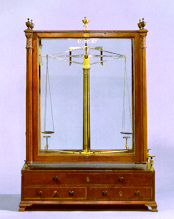
72 x 24.7 x 52.8
Steel, brass and carved wood
CAT. 1824 : C.IV.27
Uma balança de ensaio da invenção de J. J. Magalhães, com todos os petrechos necessários para se fazerem os ensaios deluados. Journal de Physique de Rozier de
1781 e 1788.
A precision balance, invented by J.J.Magellan, with all of the necessary equipment to perform the experiments. Journal de Physique de Rozier de 1781 and 1788.
In January 1781, the Journal de Physique published a letter sent to M. l'Abbé Rozier, by J. Hyacinth de Magellan where the latter presents a new model of the precision balance which he had made, and with which it was possible to obtain very precise measurements.
In this article, besides a detailed description of his balance, Magellan describes the method used to obtain precis weighing results.
The Gabinete de Física possesses two copies of that balance in its valuable collection. The oldest, dated 1797, was made in London by William and Samuel Jones as the inscription, still existent on the suspension column of the beam, shows. The second balance is a perfect replica of the first, only made in Coimbra, by Joze Joaquim de Miranda.
The actual balance is enclosed inside of a glass box with two small lateral doors allowing access to its pans. The base of this box is made of wood and is supported on three points on a second box. One of the supports is articulated and situated in the middle of one of the sides of the base. On the other supports there are two screws used to level the balance. On the inside of the glass box, slightly above the small door on the side where the screws are, is a spirit-level.
The dial consists of a lateral scale in front of which the arrow moves on one of the ends of the beam of the balance The position of the pointer in relation to the scale should be observed through a magnifying glass. In the article published in the Journal de Physique there is an illustration of the balance in which a magnifying glass is shown installed on the support where the reference for the arrow is to be found . This reference consists of a second fixed pointer. We can then assume that the balance made by Jones had already evolved in relation to the original model.
Inside of the glass box, and near its base, there are supports for each of the pans. The supports can move vertically, so that they can be used as support base for the pans while the objects to be weighed are being removed or placed onto them. Oscillations of the balance are thus avoided during this operation. Handling of the pan-supports is done from the outside of the box using a key which makes a transmission axle turn and which acts upon the levers where the supports are fixed. This whole assemblage is made of brass, having only two glass discs on the top of the pan-supports.
The lower box of the balance has three drawers. The two lower drawers are smaller than the upper one. A variety of accessories are kept in these drawers. The balance has three different beams, two of them usually found in the larger drawer.
The weights are kept in one of the smaller drawers. The larger weights are in the shape of a pyramid with a quadrangular base. The smaller ones are composed of fine copper sheets, or small brass discs which are kept in various cylindrical boxes with screw-top lids. At present, eight of those boxes exist, all of them having their own place in the drawer. Two other places are unoccupied, which suggests that some of the balance's accessories have been lost. Also in this drawer is a complete set of six crucibles, in the shape of a truncated cone, which fit into one another.
Besides the accessories already mentioned, the balance has three pairs of pans, with suspension hooks for the different beams. There are even more accessories in the drawer where the pans are kept, for example, a hammer, a clip, a commanding key for the levers that control the pan-supports, etc. It is the most complete copy of a precision trial balance which currently exists in the Gabinete de Física in Coimbra.
This balance, in addition to the gilded inscription corresponding to its inclusion in the Catalogue of 1824, also has the inscription C.IV.584 on the wooden base, a numeration which preceeds the Santorian balance (instrument 21), leading us to believe that it has also been acquired by dalla Bella. However, contrary to the former, it is not recorded in the Index of 1790 (see the last paragraph of the entry on the instrument 5).
Magellan, John Hyacinth, "Description d'une Nouvelle Balance d'Essai", Journal de Physique par M. l'Abbé Rozier, 1781, Vol. XVII, pp. 43-49.